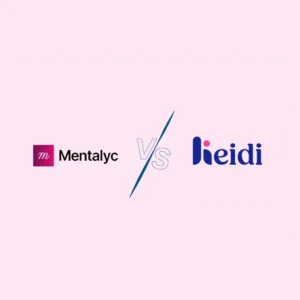Understanding medical billing is essential for serving your clients effectively. One term you’ve likely encountered is the superbill—a document for practices that offer out-of-network services. Whether you’re new to private practice or looking to streamline your billing processes, this guide will explain everything you need to know about superbills and their role in clinical practice.
What is a Superbill?
A superbill is an itemized document that mental health therapists issue to clients for submission to their insurance companies. It serves as proof of service and includes all the details required for insurance reimbursement. Unlike a standard receipt, a superbill is a comprehensive record that meets insurance providers’ documentation standards.
Superbills are commonly used by therapists who operate as out-of-network providers, enabling clients to seek reimbursement directly from their insurance companies. Think of a superbill as a bridge between your therapy practice and your client’s insurer.
A superbill contains detailed information about the services rendered during a session. For therapists, this typically includes:
- Provider Information: Name, address, contact details, license number, and National Provider Identifier (NPI).
- Client Information: Name, date of birth, and insurance policy details.
- Session Details: Date of service, type of service provided (e.g., psychotherapy), and session duration (e.g., 45 minutes).
- CPT Codes: Current Procedural Terminology codes for the specific service provided (e.g., 90834 for a 45-minute psychotherapy session).
- Diagnosis Code: The client’s diagnosis, as determined by the therapist, using ICD-10 codes (e.g., F41.1 for Generalized Anxiety Disorder).
- Fee Charged: The total amount the client paid for the session.
Providing clients with superbills is valuable in private practices where therapists are not directly contracted with insurance companies. This allows clients to receive therapy services while still leveraging their insurance benefits.
Superbills and Insurance: What Therapists Need to Know
When clients receive a superbill, they can submit it to their insurance company to request reimbursement for out-of-network therapy services. Insurance companies use the information in the superbill to determine:
1. If the service qualifies for coverage under the client’s policy.
2. The reimbursement amount based on their out-of-network benefits.
Clients should check their insurance policies for details about out-of-network coverage, deductible requirements, and reimbursement rates.
Advantages of Superbill
For Therapists
Superbill allow therapists to maintain a cash-based practice while still accommodating clients who wish to utilize their insurance benefits. There are several advantages:
1. Freedom from Insurance Panel Constraints
Therapists outside insurance networks can avoid the administrative burden and reduced reimbursement rates often associated with being in-network. This freedom allows them to set their own rates, focus on delivering quality care, and minimize paperwork.
2. Focus on Client Care
Therapists can spend more time with clients than dealing with billing and insurance approval processes, leading to a more client-centered approach.
3. Appeal to a Broader Client Base
Therapists can attract clients who wish to use out-of-network benefits, enabling them to serve clients who might otherwise feel restricted by their insurance coverage limitations.
4. Financial Stability
Maintaining a cash-based practice with the superbill option ensures therapists receive full payment upfront, reducing financial uncertainty caused by delayed reimbursements or insurance company claim denials.
5. Flexibility in Treatment Approaches
Therapists can tailor sessions to client needs without worrying about insurance coverage limitations, such as the number of sessions allowed or specific diagnoses required for reimbursement.
For Clients
Superbills make therapy more affordable and accessible, even when working with out-of-network providers:
1. Access to Preferred Therapists
Clients can choose the therapist they feel best fits their needs without being restricted to in-network providers. This primarily benefits clients seeking specialized services or therapists with specific expertise.
2. Financial Assistance
While clients pay the therapist directly, they can submit the superbill to their insurance company for partial or full reimbursement, depending on their plan. This helps offset the cost of therapy.
3. Increased Transparency
Superbills itemize the services provided, giving clients a clear understanding of the fees for each session. Transparency enhances trust between the therapist and the client.
4. Flexibility in Using Benefits
Clients can leverage out-of-network benefits, which are often underutilized. By submitting superbills, they can maximize their insurance coverage while accessing their preferred care.
5. Empowerment in Managing Care
Clients gain greater control over their mental health care decisions, as they are not limited to insurance-approved diagnoses or treatment plans. Autonomy can lead to better therapeutic outcomes.
How Superbills Work
1. Therapist Issues the Superbill
After each session or at agreed intervals, the therapist provides the client with a superbill.
2. Client Submits the Superbill
The client sends the superbill to their insurance company. Depending on the insurer’s process, the client can submit the superbill online or by mail.
3. Insurance Processes the Claim
The insurance company reviews the claim and reimburses the client based on their out-of-network coverage terms. Before starting therapy, clients should confirm their deductible, co-insurance rates, and coverage.
Example: How a Superbill Works
Consider David, who attends therapy for Post-Traumatic Stress Disorder (PTSD). David’s therapist provides a superbill with the following details:
- Therapist Information: (e.g., Dr. Jane Smith, LMFT, NPI# 1234567890)
- Client Information: David Brown, 234 Main Street, 12/01/1960
- Session Details
- Date of Service: November 22, 2024
- CPT Code: 90834, which represents a 45-minute individual psychotherapy session
- Diagnosis Code: F43.10 (Post-Traumatic Stress Disorder, Unspecified)
David pays $125 upfront for the session. His insurance plan covers 70% of out-of-network costs after he has met a $250 deductible. Since David has already met his deductible, his insurance company reimburses him $87.50 (70% of $125) after processing the superbill.
Key Takeaways from the Example
1. Therapist Documentation: Accurate and complete documentation, including CPT and diagnosis codes, ensures the insurance company processes the claim correctly.
2. Client Responsibilities: Clients must understand their insurance benefits, including deductibles, co-insurance rates, and out-of-network reimbursement policies.
3. Flexibility for Therapists and Clients: Therapists receive payment in full at the time of the session. Clients can still utilize their insurance benefits for reimbursement, reducing their overall out-of-pocket costs.
4. Diagnosis-Specific Coding: Using appropriate diagnosis codes (e.g., F43.10 for PTSD) ensures accurate claims processing and maximizes the likelihood of reimbursement.
How to Submit a Superbill to Insurance
Step 1: Prepare the Superbill
Ensure the superbill contains all the necessary details:
- Provider and client information
- Accurate CPT and diagnosis codes
- Session date and cost
Step 2: Client Submission
Clients must typically submit the superbill through their insurance provider’s claims process, which may include:
- Logging into the insurance portal and uploading the superbill.
- Mailing the superbill to the insurance company’s claims department.
Step 3: Monitor the Claim
Once submitted, clients can track their claim status. Please encourage them to keep copies of all documents and note claim reference numbers.
Tip for Therapists: Provide a simple guide or checklist to help clients submit their superbills, reducing their anxiety about this process.
Reimbursement: What Therapists Should Communicate to Clients
Reimbursement is not guaranteed, depending on the client’s insurance policy and whether the session meets coverage criteria. Here’s what to clarify with clients:
1. Out-of-Network Coverage: Clients need to confirm their policy includes out-of-network benefits.
2. Deductibles: Many policies require clients to meet a deductible before receiving reimbursement.
3. Reimbursement Rates: Insurance companies typically reimburse a percentage of the session fee, such as 50% or 80%.
Example: Understanding Reimbursement Rates
John has a $500 deductible and 70% out-of-network reimbursement. He submits a $150 superbill. If John’s deductible is not met, he won’t receive reimbursement. Once his deductible is met, his insurer will reimburse him $105 (70% of $150).
Counterfeit Superbills
Inaccuracies or intentional fraud in superbills can lead to significant issues for both therapists and clients. Insurance companies may reject claims, and in severe cases, fraudulent activity could lead to legal consequences. The creation or use of counterfeit superbills—whether due to inaccuracies or intentional fraud—poses severe risks for both therapists and clients.
Risks for Therapists
1. Damage to Professional Reputation
If a therapist knowingly or unknowingly provides fraudulent superbills, it can tarnish their reputation, potentially leading to losing clients and trust within their professional community. Licensing boards may also investigate ethical breaches, jeopardizing the therapist’s ability to practice.
2. Legal Consequences
Fraudulent superbills can lead to allegations of insurance fraud, which can result in significant fines, legal action, or even imprisonment. Therapists found guilty of fraud may also face civil lawsuits from insurance companies.
3. Financial Loss
Insurance companies may demand reimbursement for fraudulent claims, putting therapists under financial strain. Additionally, therapists may incur legal fees defending against fraud accusations.
4. Compliance Audits and Increased Scrutiny
Therapists implicated in fraud may be subject to audits from insurance companies and regulatory bodies, which can increase administrative burdens and limit their ability to work with specific clients or insurers in the future.
Risks for Clients
The client’s insurance company may reject the claim if a superbill contains errors or is considered fraudulent. This leaves the client responsible for the total cost of therapy sessions, potentially creating financial strain.
2. Legal Implications.
Clients who knowingly submit counterfeit superbills for reimbursement can be accused of insurance fraud and may face penalties, fines, or legal action.
3. Ineligibility for Future Claims.
Fraudulent activity can lead to blacklisting by insurance companies, making it harder for clients to file legitimate claims in the future.
4. Trust Issues with Therapists.
Discovering inaccuracies in superbills can erode trust between clients and therapists, damaging the therapeutic relationship.
Common Sources of Errors or Fraud
- Unintentional Errors:
- Mistakes in CPT or diagnosis codes
- Incorrect session dates or fees
- Missing or incomplete information
- Intentional Fraud:
- Inflated session charges
- False claims for sessions that did not occur
- Misrepresentation of the therapist’s credentials or licensure
How to Avoid Counterfeit Superbills
1. Use EHR Software
Many electronic health record (EHR) systems, like SimplePractice or TherapyNotes, include built-in superbill generation tools that ensure accuracy and compliance.
2. Regular Audits
Periodically review superbills to verify that all details, such as CPT and diagnosis codes, are correct.
3. Educate Clients
Inform clients about the importance of submitting authentic superbills and caution them against altering the document.
Superbill Template
Below is an example template:
Provider Information:
Name: [Your Name]
Practice Name: [Your Practice Name]
Address: [Your Practice Address]
Phone: [Your Phone Number]
Email: [Your Email]
NPI: [Your NPI]
License Number: [Your License Number]
Client Information:
Name: [Client’s Full Name]
Date of Birth: [Client’s DOB]
Insurance Provider: [Client’s Insurance]
Policy Number: [Policy Number]
Session Details:
Date of Service: [MM/DD/YYYY]
Service Provided: [Description of Service]
CPT Code: [CPT Code]
ICD-10 Diagnosis Code: [Diagnosis Code]
Fee Charged: [Total Fee]
Notes:
This document does not guarantee reimbursement. Please contact your insurance provider for details about your benefits.
Tips for Using Superbills
1. Standardize Your Process: Use EHR software to automate superbill creation and minimize human error.
2. Educate Clients: Offer a brief explanation about how superbills work and what clients need to do with them. Create a form or guide to make the process easier for your clients.
3. Clarify Fees: Discuss your session fees and how they relate to insurance reimbursement rates.
4. Stay Updated: Familiarize yourself with insurance coding updates to ensure your superbills remain compliant.
Conclusion
By mastering the creation, use, and submission of superbills, you can enhance your practice’s accessibility and client satisfaction while maintaining your preferred business model. Leveraging templates, EHR systems, and transparent client communication will ensure a seamless experience.
Reference
- TheSuperBill.com (2024). What is a Superbill? The Complete Guide to Superbills. Retrieved from: https://www.thesuperbill.com/blog/what-is-a-superbill?
Disclaimer
All examples of mental health documentation are fictional and for informational purposes only.
Why other mental health professionals love Mentalyc

“If I were recommending this software to a colleague, I would tell them that it is the best thing that they could do for their practice.”
Licensed Professional Counselor

“Do yourself a favor, make your life easier. Use the tools that are readily available … I found Mentalyc to be one of the best tools that I’ve ever used.”
Licensed Marriage and Family Therapist

“It immediately changed my quality of life, personally and professionally. I went from 3–4 hours a week of notes to 1 hour at most … that alone is invaluable personally and professionally.”
Owner/Independently Licensed Marriage & Family Therapist (IMFT)

“For those who have hesitations … It is a lifesaver. It will change your life and you have more time to be present with your patients.”
Licensed Clinical Social Worker






